Energy Flow In An Ecosystem
Maharashtra Board-Class 9-Science & Technology-Chapter-7
Notes
|
Topics to be learn :
|
Ecosystem : The biotic and abiotic factors and their mutual interactions form an ecosystem.
Types of ecosystem: There are two types of ecosystem, viz., aquatic ecosystem and terrestrial ecosystem.
Interactions between biotic and abiotic factors of an ecosystem :
- Every living organism requires specific abiotic factors for its survival.
- The type of soil, quality of light, temperature, humidity, etc. are some of the abiotic factors that affect the biotic factors.
- Living organisms (biotic factors) constantly interact with the abiotic factors. They affect the quality of abiotic factors surrounding them. This indirectly affects the quality of other biotic factors sharing the same ecosystem.
- In any ecosystem, every living organism plays a specific role with respect to other factors.
Energy flow in an ecosystem :
Primary consumers (herbivores) : They are directly dependent on autotrophs (producers). Ex. Grasshopper, squirrel, elephant, etc.
Secondary consumers (carnivores) : These consumers use herbivores as their food. Ex. Frog, owl, fox, etc.
Apex or top consumers (carnivores) : These consumers use herbivores and carnivores as their food. No other animals feed on top consumers. Ex. Tiger, lion, etc.
Omnivores (mixed consumers) : Feed on herbivores and carnivores. Ex. Humans, bear, etc.
Food chain and Food web :
Food chain: Feeding relationships among producers, consumers and saprophytes in an ecosystem is called food chain. Each chain consists of four, five or more links.
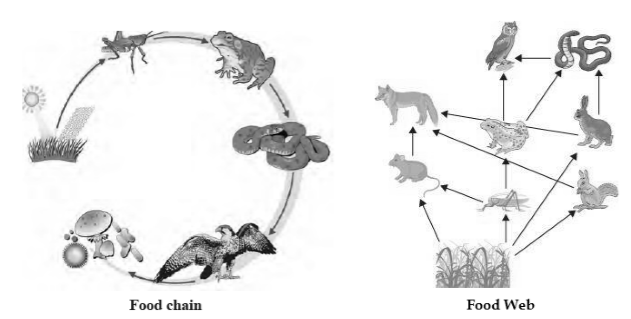
Food web : Food webs are interconnected food chains in an ecosystem.
- Food webs are intricate and complex intertwining of different food chain
- In nature, food chains are never simple. One organism can feed on a variety of other organisms and in turn can be eaten up by another set of predators. This forms a web-like relationships between different organisms.
- An insect may eat leaves, seeds or fruits. This insect has many predators such as frog, lizard, bird or a mammal like rat. The bird may eat a rat too.
- Frog eats insects but can be consumed by a snake. Snake in turn can be picked up by a bird. Snake can eat a rat too.
- So the feeding relations are rarely simple.
This intricate complex network, called food web Operates in every ecosystem.
Producer : Consumer :
Energy Pyramid : Energy Pyramid is the diagrammatic representation showing how the energy travels up in a food chain through different trophic levels. Figure shows the energy transfer that takes place at each trophic level. There are different levels of energy exchange in the food chain. The initial quantity of energy goes on decreasing at every level of energy exchange. Similarly, the number of organisms also decreases from the lowest level to the highest level. This pattern of energy exchange in an ecosystem is called a ‘Pyramid of energy’.
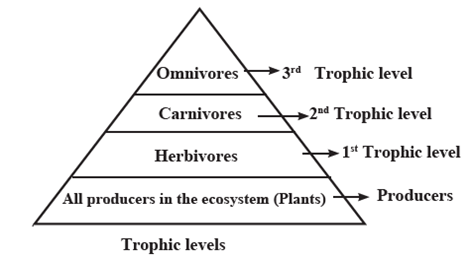
Distinguish between Energy flow and flow of nutrients in an ecosystem : 2-The energy from producers to consumers is passed from one trophic level to the other trophic level. 3-Some part of energy which is not utilized is thrown into the atmosphere. 2-Nutrients from producers is passed from primary consumers and from primary consumers to secondary consumers. Only decomposers make the nutrients available in a cyclic way. 3-Nutrients are not destroyed into the ecosystem.
Energy flow in an ecosystem
Fow of nutrients in an ecosystem
1-Flow of energy in an ecosystem is unidirectional.
1-Flow of nutrients in an ecosystem is cyclic.
Bio-geochemical cycle :
- The cyclic flow of nutrients within an ecosystem is called bio-geochemical cycle.
- The bio-geochemical cycles provide different types of nutrients to all living organism for their growth and development.
- Nutrients that are necessary for the growth and development of organisms are continuously transferred from abiotic to biotic factors and vice versa within an ecosystem.
- The bio-geochemical cycle operates through the medium of the biosphere which is formed by the lithosphere, hydrosphere and atmosphere.
- The recycling of chemical, geological and biological sources of nutrients is a complex process and is completely dependent upon the transfer of energy level in the ecosystem.
Types of Bio-geochemical cycle : There are two main types of bio-geochemical cycle, viz. gaseous cycle and sedimentary cycle. Gaseous cycle : Sedimentary cycle :
Carbon cycle, oxygen cycle and nitrogen cycle are the most important bio-geochemical cycles.
Carbon cycle : The circulation and recycling of carbon from the atmosphere to living organisms and after their death back to the atmosphere is called the carbon cycle. 6CO2 + 12H2O \(\frac{sunlight}{Chlorophyll}\)> C6H12O6 + 6H2O + 6O2 C6H12O6 + 6 O2 ---> 6CO2 + 6 H2O + Energy
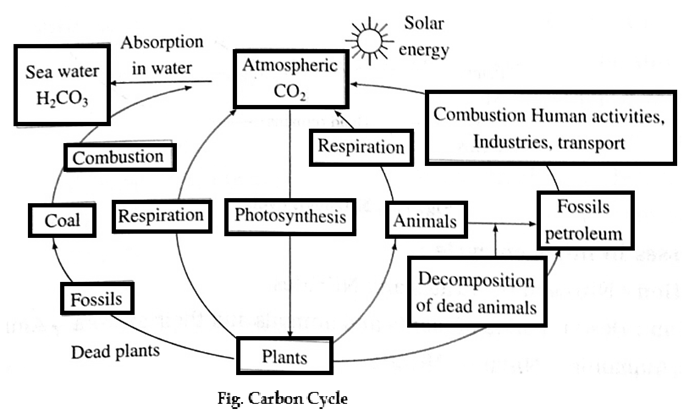
|
Oxygen cycle :
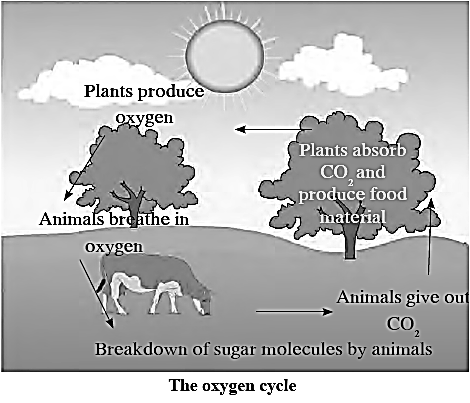
Nitrogen cycle : The circulation and recycling of nitrogen gas into the form of different compounds through various biotic and abiotic processes in nature is called the nitrogen cycle.
- The atmospheric nitrogen moves from atmosphere to the soil,
- from the soil to the plants,
- from plants to the animals and
- from all the living beings to the soil and
- from the soil back to atmosphere.
This cyclic journey of the nitrogen is called nitrogen cycle.
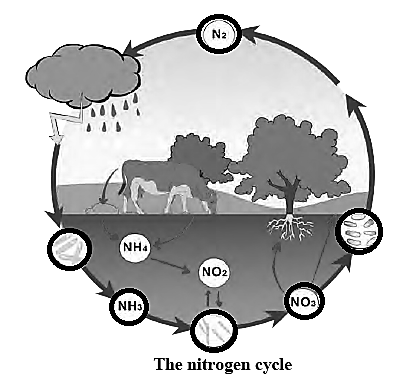
Important processes of the nitrogen cycle 1) Nitrogen fixation: Conversion of nitrogen into nitrates and nitrites through atmospheric, industrial and biological processes. There are two processes of nitrogen fixation. viz., physical fixation : Further divided into atmospheric fixation and industrial fixation and biological fixation. (a) Physical fixation : The lightning in the sky brings about oxidation of atmospheric nitrogen and converts it into nitrogen oxide (NO2). Nitrogen oxide dissolves in rain water and forms nitrous and nitric acid. These acids seep in the soil with the rain water. They undergo chemical reactions with other elements in soil and form different compounds of nitrogen. (b) Biological fixation : 2) Ammonification: Release of ammonia through decomposition of dead bodies and excretory wastes of organisms. 3) Nitrification: Conversion of ammonia into a nitrite and then nitrate. 4) Denitrification: Conversion of nitrogen compounds into gaseous nitrogen.
| Source of Nitrogen : Plants cannot take the atmospheric nitrogen as it is. Therefore they take up various compounds of the nitrogen that are available in the soil. For the plants nitrogen compounds in the soil is the only source of nitrogen. |
Useful links :
| Main Page : - Maharashtra Board Class 9th Science & Technology - All chapters notes, solutions, videos, test, pdf.
Previous Chapter : Chapter 6:Classification of plants - view online Notes Next Chapter : Chapter 8: Useful and Harmful Microbes -view online Notes |
So nice notes
Best notes I like your notes